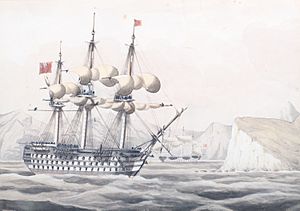HMS Britannia (1820) facts for kids

Watercolor of HMS Britannia, c. 1834, by John H. Wilson
|
|
Quick facts for kids History |
|
|---|---|
| Name | HMS Britannia |
| Ordered | 6 November 1812 |
| Builder | Devonport Dockyard |
| Laid down | December 1813 |
| Launched | 20 October 1820 |
| Fate | Broken up, 1869 |
| General characteristics as built | |
| Class and type | Caledonia-class ship of the line |
| Tons burthen | 2616 bm |
| Length | 205 ft (62 m) (gundeck) |
| Beam | 53 ft 6 in (16.31 m) |
| Depth of hold | 23 ft 2 in (7.06 m) |
| Propulsion | Sails |
| Sail plan | Full-rigged ship |
| Armament |
|
| General characteristics after 1839 | |
| Armament |
|
HMS Britannia was a huge sailing warship of the Royal Navy. It was known as a "first-rate ship-of-the-line" because it carried 120 guns. This made it one of the biggest and most powerful ships of its time. The ship was ordered in 1812 and launched on October 20, 1820.
Early Years and Service
Britannia was officially ready for duty in 1823. It served in the Mediterranean Sea from 1830 to 1831 and again in 1841. After these duties, the ship was taken out of service in 1843.
The Crimean War
Britannia returned to active duty for the Crimean War. From 1851 to 1854, it was the main ship for Admiral Sir James Whitley Deans Dundas. He commanded the British fleet in the Mediterranean and Black Sea.

On October 17, 1854, Britannia took part in the Bombardment of Sevastopol. This was a major battle during the Crimean War. Later, on November 14, 1854, a huge storm hit. Britannia was pushed ashore on the Russian coast. Reports said it had 1.5 meters (5 feet) of water inside its lower part.
Later Life and Legacy
Britannia returned to England in early 1855. That same year, it became a hospital ship in Portsmouth. This meant it was used to care for sick or injured sailors.
Training Future Sailors
In 1859, Britannia was changed into a training ship for young naval cadets. These cadets were students learning to become naval officers. The ship moved to Portland in 1862. Then, in 1863, it moved to Dartmouth. Here, it served as a place for cadets to live and study.
Britannia was finally sold and taken apart in 1869. Another ship, HMS Prince of Wales, took its place at Dartmouth. This ship was then renamed Britannia to continue the tradition.
Many famous naval officers started their careers on these two Britannia ships. Some of them include John Fisher, John Jellicoe, and even King George V.


